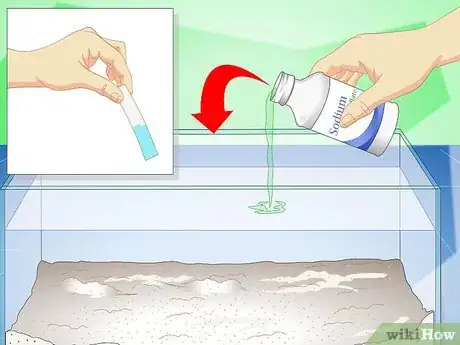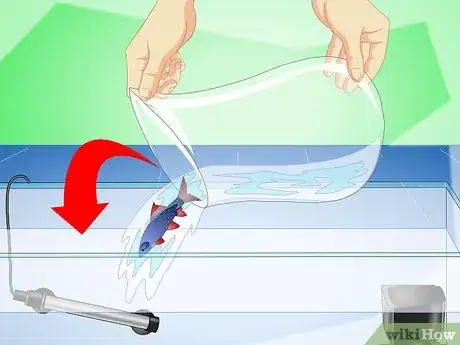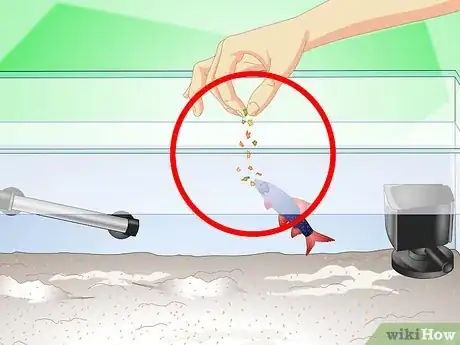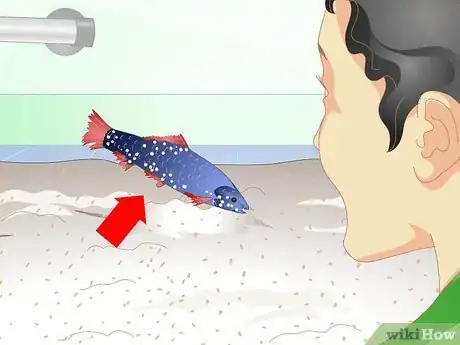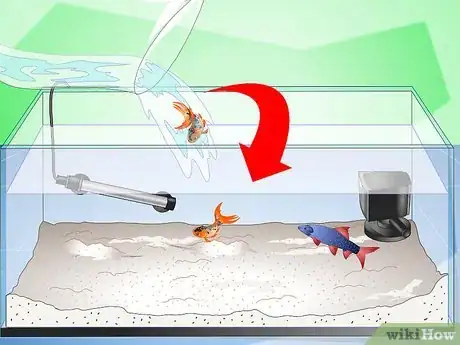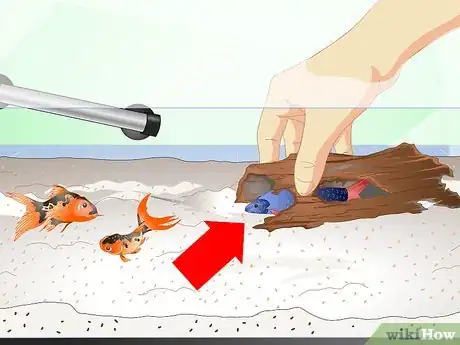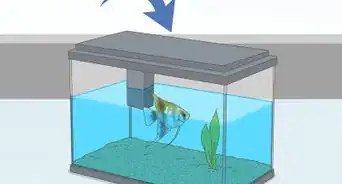This article was co-authored by wikiHow Staff. Our trained team of editors and researchers validate articles for accuracy and comprehensiveness. wikiHow's Content Management Team carefully monitors the work from our editorial staff to ensure that each article is backed by trusted research and meets our high quality standards.
There are 13 references cited in this article, which can be found at the bottom of the page.
wikiHow marks an article as reader-approved once it receives enough positive feedback. In this case, 86% of readers who voted found the article helpful, earning it our reader-approved status.
This article has been viewed 123,465 times.
Learn more...
The rainbow shark is a brightly colored fish from Southeast Asia and a favorite for fish owners. Although not technically a shark, the rainbow shark is as aggressive as its namesake. If you are willing to bend the truth a little bit, you can claim to be the proud owner of a shark. After setting up your freshwater tank, be sure to give the water a few weeks to cycle before introducing your fish. The most difficult part of maintaining a happy shark will be finding tank mates that this aggressive breed is willing to live with.
Steps
Preparing Your Shark Tank
-
1Purchase an aquarium that can hold at least 50 gallons. Rainbow sharks are not particularly large, only about 6 inches (15 cm). However, they are semi-aggressive and very territorial. These fish need plenty of space and hiding spots to prevent confrontations.[1]
- You might be required to assemble the aquarium. Follow the instructions on the box, because these will vary from tank to tank.
- Purchase a heater and filter to go with the tank. Be sure that the filter is designed for a tank of your size. Refrain from using an under-gravel filter, because it is not compatible with sand, which is the optimal substrate for rainbow sharks. [2]
- You should also purchase a tank stand designed to accommodate an aquarium of your size. While it might be attractive to use a table or desk that you already own, these often will not be strong enough to hold a heavy tank. Similarly, putting an aquarium on the floor is very dangerous.
-
2Find a safe location for your aquarium. The tank should be placed far away from environmental factors that can cause large variations in temperature: windows, air conditioners, radiators, and air vents. It should also be located away from noise and foot traffic. Avoid spots near doors, on the floor, or in a busy hallway.
- You should also try to find a place that is near a power plug, a water source, and where you have space to both work on and observe the tank.[3]
Advertisement -
3Put sand and hiding places on the bottom of the aquarium. Gravel with sharp edges can scratch up and damage the rainbow shark. Very fine gravel or, even better, sand should be used as a substrate. Because the rainbow shark is territorial, you will also need plenty of places for the rainbow shark to hide.
- Caves, tubes, and other tank decorations sold at pet stores can help prevent conflict between territorial fish.[4]
- You should also purchase live plants for the tank. These are a good source of distraction for fish and help to keep the tank clean.
-
4Pour water into the tank. Tap water should be fine for your shark, though you will need to treat it. Fill the tank near to the top, but leave a few inches of headspace. It is necessary to keep a layer of oxygen at the top of the tank.[5] Once you introduce the shark, you'll need to keep the tank covered with a lid to prevent the shark from jumping out.[6]
-
5Treat the water. Tap water usually contains chlorine and other substances that are harmful to your fish. You can purchase a water testing kit at the pet store to determine what chemicals you'll need to make the water safe for your shark. You will probably need a sodium thiosulfate solution to treat chlorine and Amquel to treat chloramine.
- To get more information about the chemicals in your water supply, ask the local pet store owner or call the water utility directly.[7]
- In addition to adding sodium thiosulfate and Amquel to the tank, treat the tank for pH levels. There are a variety of acids and bases that can be purchased at the pet store to adjust the pH level in your tank.[8] Test the level and adjust the pH until it is in the range of 6.5 to 7.5 pH.[9]
-
6Allow the water to sit for two weeks before introducing fish. It is important to allow time for the water to cycle and for the chemical composition of the water to stabilize. Continue to closely monitor the chemicals to verify that they are at safe levels.
-
7Keep the tank at a moderate temperature. Rainbow sharks like a water temperature from 72-79 Fahrenheit. To keep the tank at this temperature, purchase a heater to go with your tank. Set the heater somewhere between the 72-29 degree temperature range.[10]
- You should also be sure to keep your aquarium away from anything that could cause it to suddenly change temperature. For example, keep it away from windows, heaters, and vents.
-
8Move your shark to its tank soon after purchase it. Even a shark cannot survive more than a couple of hours in the bag that the pet store gives you to bring it home in. When you bring the fish home, float the bag in the aquarium water for half an hour so that fish can adjust to the aquarium's water temperature. Then add some water from your tank to the bag to help the fish get used to the new water.[11] Afterwards use a net to transfer the fish into the tank. Discard the old water instead of adding it to the tank, since the waste in the water makes for an inhospitable environment.
Caring for Your Shark
-
1Feed it a diverse diet. Rainbow sharks are omnivorous and can and should eat most anything. Sharks will eat any common fish food, including pellets, flakes and algae wafers, as long as it sinks to the bottom of the tank. To give you sharks a brighter coloration, make sure to feed it small crustaceans a few times a week. Feed your shark two to three times daily.[12]
- Experiment to determine how much you should feed your fish. A fish should eat its food within approximately five minutes. If anything is remaining after that period of time, you have given your fish too much food. Excess food will ultimately make the tank dirty.[13]
- Good crustaceans or insects to feed your fish include brine shrimp, bloodworms, Daphnias, and artemias.[14]
- You should also feed your sharks vegetables.[15] Try Zucchini that has been sliced into small bits and boiled. Boiled peas can also be good. Rainbow sharks will eat some raw vegetables, including romaine lettuce, beet tops, and swiss chard. When feeding your fish cooked vegetables, be sure to let them cool before placing them in the aquarium.[16]
-
2Clean the tank weekly. When you clean the tank, you do not need to remove all of the substrate (sand or gravel), however, you should use a siphon to suck up the waste that accumulates on the bottom of the tank. Use a scraper to remove algae from the glass. After finishing these tasks, remove and replace 10-15% of the water.
- Do not remove fish when changing the water. This will cause unnecessary stress.
- When replacing the water, put new water into a bucket. Do not use this bucket for any other household tasks (it might accumulate dangerous chemicals). Test and treat the water as discussed previously. Use a siphon to slowly introduce the new water back into the tank.[17]
-
3Watch for signs of illness. It is particularly important to watch for signs of illness with fish. That because many fish diseases are highly communicable and will spread rapidly throughout the tank. Many common causes of illness are also the result of bad water conditions and might quickly kill off all of your fish. Things to watch for include:
- Scratching against objects in the tank
- Duller coloration, changes in color pattern, and spotting
- Gills and fins that have been chewed on
- Lack of energy
- Fins tightly held against the body
- Bloating
- Gasping for air at the surface of the water
- Disappearing fin or tail[18]
Socializing Your Shark
-
1Choose a few semi-aggressive fish to introduce. Rainbow sharks will be less likely to fight with other fish who can defend themselves against the rainbow shark. However, you need more than two, or else those will fight among themselves all the time. The rainbow shark will be most likely to fight with members of its own species.
- If you do try to introduce another rainbow shark into the tank, you need at least a meter of separated territory for each of the sharks.
- Rainbow sharks are most likely to get along with fish from the Chromobita, Botia, Syncrossus, and Yasuhikotakia genera. Gouramies, barbs, and danios are good companions.
- Rainbow sharks will be more hostile toward fish from the Crossocheilus, Garra and Gyrinocheilus genera. Small fish and bottom feeders, including catfish and cichlids, are also more likely to be disturbed by rainbow sharks.[19]
-
2Provide places to hide. If you include caves and tubes in the tank, your shark will claim these as its territory and be less likely to fight with other fish. Visit a fish store to see what type of hiding places are available. If your rainbow shark finds a cave that it likes to hide in, but is still prone to aggression, you can purchase a divider for your tank, that will prevent it from interacting with the other fish.[20]
-
3Do not expect to breed your sharks. Because these sharks are so prone to fight with other members of their species, it is very difficult, if not quite impossible to breed them. However, if you hope to do so you will have to provide a tank that is at least 75 gallons.
- It is impossible to determine the sex of the shark as juveniles. Ever afterward, it is hard. The females will be slightly thicker and black lines on their fins.[21]
- Rainbow sharks are most likely to breed after they have reached at least 4 inches (10.2 cm) long and during the months of October and November. You will likely need to treat them with hormones to encourage mating. They should be fed with high protein foods, like shrimp and tuna.
- After fry hatch, they should be transferred to a separate 10-gallon tank and should be fed liquid fry food for two weeks before shifting to baby brine shrimp.[22]
Community Q&A
-
QuestionCan I put goldfish and koi carp in with rainbow sharks?
 Community AnswerNo! Goldfish and koi are cold water fish, whereas rainbow sharks are tropical. They need completely different temperatures to survive and thrive.
Community AnswerNo! Goldfish and koi are cold water fish, whereas rainbow sharks are tropical. They need completely different temperatures to survive and thrive. -
QuestionMy rainbow shark always hides. How do I know he is okay?
 Community AnswerIf you have other fish in the tank that are bullying him, remove them. Check for injuries.
Community AnswerIf you have other fish in the tank that are bullying him, remove them. Check for injuries. -
QuestionIntroduced my rainbow to the tank (65g) yesterday, and he just seems to hang out on the glass from about midway to the top of the tank. He did eat last night, but hasn't been too active. Should I be concerned?
 Community AnswerDon't be alarmed, they love to hang out in one or two spots. This keeps them low-stress, as they feel safe and secure. Always make sure to check on them when feeding, as this is when they should definitely leave their spot to get their energy for nocturnal swimming.
Community AnswerDon't be alarmed, they love to hang out in one or two spots. This keeps them low-stress, as they feel safe and secure. Always make sure to check on them when feeding, as this is when they should definitely leave their spot to get their energy for nocturnal swimming.
References
- ↑ http://www.fishlore.com/profiles_rainbow_shark.htm
- ↑ https://www.aqua-fish.net/articles/advice-keeping-rainbow-sharks-focusing-temperament-tank-setup
- ↑ http://petskeepersguide.com/the-location-to-set-up-a-home-aquarium/
- ↑ https://www.aqua-fish.net/articles/advice-keeping-rainbow-sharks-focusing-temperament-tank-setup
- ↑ https://users.cs.duke.edu/~narten/faq/water-treatment.html
- ↑ https://www.aqua-fish.net/articles/advice-keeping-rainbow-sharks-focusing-temperament-tank-setup
- ↑ https://users.cs.duke.edu/~narten/faq/water-treatment.html
- ↑ http://www.tfhmagazine.com/aquarium-basics/water-treatment.htm
- ↑ https://animals.mom.com/how-to-breed-rainbow-sharks-7808414.html
- ↑ http://www.liveaquaria.com/product/prod_display.cfm?c=830+888+1081&pcatid=1081
- ↑ http://www.hartz.com/Fish/Habitat/How_to_Introduce_New_Fish_into_Your_Aquarium_Tank.aspx
- ↑ http://aquaticmag.com/freshwater/fish/rainbow-shark-information/
- ↑ http://www.petmd.com/fish/nutrition/evr_fi_fish_food
- ↑ https://www.aqua-fish.net/articles/advice-keeping-rainbow-sharks-focusing-temperament-tank-setup
- ↑ http://www.liveaquaria.com/product/prod_display.cfm?c=830+888+1081&pcatid=1081
- ↑ http://www.aquaticcommunity.com/fishfood/vegetables.php
- ↑ http://www.firsttankguide.net/waterchange.php
- ↑ http://www.tetra-fish.com/aquarium-information/aquarium-fish-diseases-how-to-spot-them.aspx
- ↑ https://www.aqua-fish.net/articles/advice-keeping-rainbow-sharks-focusing-temperament-tank-setup
- ↑ https://www.aqua-fish.net/articles/advice-keeping-rainbow-sharks-focusing-temperament-tank-setup
- ↑ http://aquaticmag.com/freshwater/fish/rainbow-shark-information/
- ↑ http://aquaticmag.com/freshwater/fish/rainbow-shark-information/
About This Article
To care for a rainbow shark, choose a tank that holds at least 50 gallons of water, since rainbow sharks need much more space than the average freshwater fish. Additionally, purchase a heater for your tank to ensure that the water temperature stays between 72 to 79 degrees Fahrenheit. In order to feed your rainbow shark, give it a diverse diet of fish pellets, small crustaceans, and small bits of vegetables 2 to 3 times a day. However, make sure to give it no more than what it can eat in 5 minutes to prevent food debris from accumulating in the tank. For more advice from our Veterinary co-author, like how to introduce new fish into your rainbow shark’s tank, read on!




